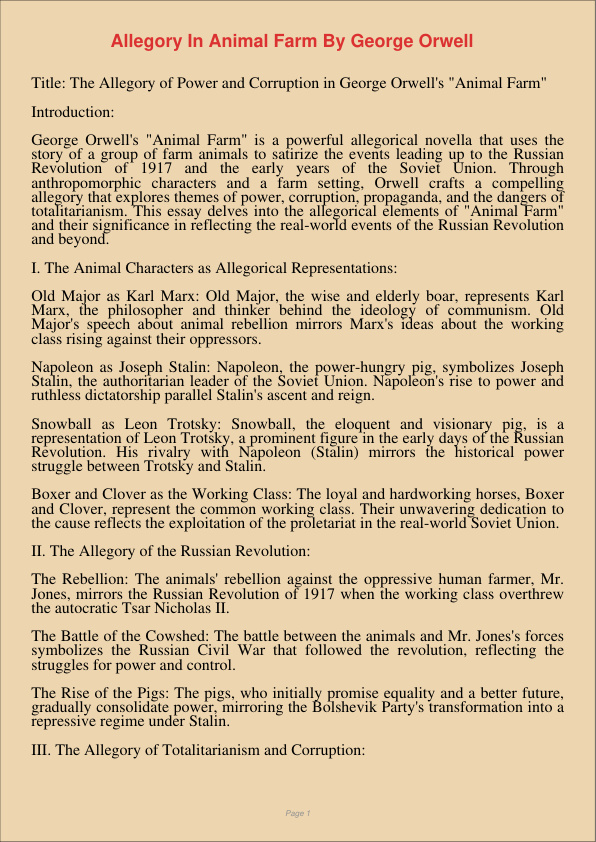
Title: The Allegory of Power and Corruption in George Orwell’s “Animal Farm”
Introduction:
George Orwell’s “Animal Farm” is a powerful allegorical novella that uses the story of a group of farm animals to satirize the events leading up to the Russian Revolution of 1917 and the early years of the Soviet Union. Through anthropomorphic characters and a farm setting, Orwell crafts a compelling allegory that explores themes of power, corruption, propaganda, and the dangers of totalitarianism. This essay delves into the allegorical elements of “Animal Farm” and their significance in reflecting the real-world events of the Russian Revolution and beyond.
I. The Animal Characters as Allegorical Representations:
Old Major as Karl Marx: Old Major, the wise and elderly boar, represents Karl Marx, the philosopher and thinker behind the ideology of communism. Old Major’s speech about animal rebellion mirrors Marx’s ideas about the working class rising against their oppressors.
Napoleon as Joseph Stalin: Napoleon, the power-hungry pig, symbolizes Joseph Stalin, the authoritarian leader of the Soviet Union. Napoleon’s rise to power and ruthless dictatorship parallel Stalin’s ascent and reign.
Snowball as Leon Trotsky: Snowball, the eloquent and visionary pig, is a representation of Leon Trotsky, a prominent figure in the early days of the Russian Revolution. His rivalry with Napoleon (Stalin) mirrors the historical power struggle between Trotsky and Stalin.
Boxer and Clover as the Working Class: The loyal and hardworking horses, Boxer and Clover, represent the common working class. Their unwavering dedication to the cause reflects the exploitation of the proletariat in the real-world Soviet Union.
II. The Allegory of the Russian Revolution:
The Rebellion: The animals’ rebellion against the oppressive human farmer, Mr. Jones, mirrors the Russian Revolution of 1917 when the working class overthrew the autocratic Tsar Nicholas II.
The Battle of the Cowshed: The battle between the animals and Mr. Jones’s forces symbolizes the Russian Civil War that followed the revolution, reflecting the struggles for power and control.
The Rise of the Pigs: The pigs, who initially promise equality and a better future, gradually consolidate power, mirroring the Bolshevik Party’s transformation into a repressive regime under Stalin.
III. The Allegory of Totalitarianism and Corruption:
The Commandments: The Seven Commandments, initially established for the animals’ equality, gradually erode as the pigs take more control. This mirrors the erosion of democratic principles in the Soviet Union, with the commandments symbolizing the Soviet constitution.
Squealer’s Propaganda: Squealer, the persuasive and manipulative pig, represents the propaganda machine used by totalitarian regimes to control and manipulate the masses. His persuasive speeches and distortions of the truth mirror the propaganda employed in real-world dictatorships.
The Betrayal of the Working Class: The animals’ gradual realization that they are no better off under the pigs’ rule reflects the disillusionment of the working class in the face of corruption and betrayal by their leaders.
Conclusion:
“Animal Farm” is a masterful allegory that uses a farm full of animals to shed light on the events of the Russian Revolution and the early Soviet Union. Through its anthropomorphic characters and farmyard setting, the novella serves as a cautionary tale about the dangers of totalitarianism, corruption, and the abuse of power. George Orwell’s “Animal Farm” remains a timeless work that continues to resonate as a powerful allegory of the human condition and the complexities of governance.
「真诚赞赏,手留余香」
真诚赞赏,手留余香
使用微信扫描二维码完成支付
